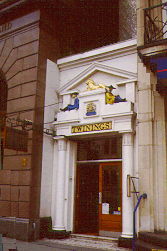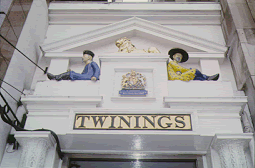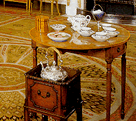Clubs and societies
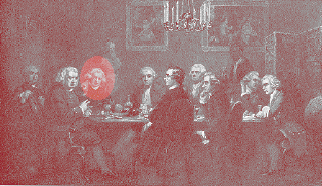
- at Sir Joshua Reynolds’s
- [click on the picture to enlarge it]
“It was said of Socrates, that he brought Philosophy down from Heaven, to inhabit among Men; and I shall be ambitious to have it said of me, that I have brought philosophy out of Closets and Libraries, Schools and Colleges, to dwell in Clubs and Assemblies, at Tea-Tables, and in Coffee-Houses.”
Joseph Addison, The Spectator, n°10, Monday, March 12, 1711
Tea
Tea was introduced into Britain around 1650.
It came from China (it was grown in India only from the 19th century).
It was very expensive (largely because of taxes), so that it was not entrusted to servants in the kitchen, but made by the lady of the house in the drawing room in front of her guests; not only the the tea-pot, but also the tea-caddy, the kettle and the stand had to be elegant.
In 1784, tea merchants campaigned to obtain a reduction of taxes so that tea would become affordable for working people and replace the adulterated drinks they so far drank, and the ale which had risen in cost because of high grain prices.
The Methodists advocated tea drinking to fight alcoholism.
In London, Thomas Twining (1675-1741) purchased Tom’s Coffee House near the Strand in 1706 and introduced tea.
On the same site in 1717 he founded the Golden Lyon to sell tea and coffee.
In 1787 his grandson Richard Twining (1749-1834) built the doorway with a lion and two Chinese figures, of Coade stone.
"Thomas and Daniel Twining,
At the Golden Lyon in Devereux-Court, near the Temple, sell all sorts of fine Teas, Coffee, Chocolate, Cocoa-Nuts, Saggo, and Snuff: Also true German Spaw, Pyrmont, Bath and Bristol Waters, Arrack, Brandy, &c"Tea-wrapper 1737
Drawing room
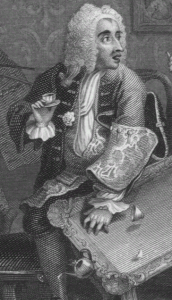
- Harlot quarelling with her protector
- [click on the picture to enlarge it]
In the early 18th century, tea was frequently drunk from bowls, as can be seen in Hogarth’s print of The Harlot’s Progress (1732), showing the harlot quarelling with her protector, in a rococo setting (the tea-table).
- Tea would be drunk in a family parlour (as shown nowadays in the ’Georgian House’ in Edinburgh)
- or with guests in the drawing room (as at ’Number One’ in Bath).
Tea would be drunk after dinner by the ladies when they withdrew to the drawing room while the gentlemen stayed for some time in the dining room to drink port before joining the ladies.
Tea-drinking parties in Bath are described by Smollett’s character Jerry.
Visitors to Bath, such as Elizabeth Giffard in her Diary, record buying tea in a list of “requisites relative to housekeeping.”

